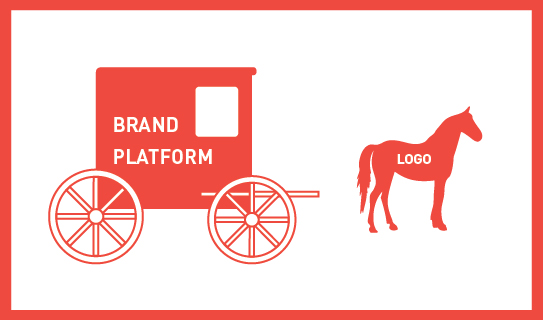Don’t hire us to create your logo. Not us, nor anyone else therefor. Sure, we could create a great logo for you. It would look timeless, be very well designed (I believe we are one of the best, and many agree), it would work across platforms and for years to come, and everybody would be telling you how much they love it. So why shouldn’t you hire us to create this important piece of branding for you?
Chances are you don’t need a logo designed. Not yet.
Chances are you need a brand built, and your logo is just a part of it. By creating a logo in a vacuum, and out of sync, you will likely fail. I don’t want you to fail. Nor be part of failure. I think we share this belief as entrepreneurs.
It’s the cart before the horse idiom: Why put the horse in place if we don’t know the message by the messenger yet?

Below are 4 key elements you have to have in place prior to embarking on your logo design; they are the bare minimum requirements, the wheels of your cart so to speak:
1. You have a positioning statement in place that focuses on the ‘why’ and you stand tall behind it
2. You created 3 target audience personas that stand for who you are actually talking to/with
3. You know your brand personality and its associated keywords and are ready to act upon it
4. You have created a meaningful name that responds successfully to all of the above
If you don’t have these in place, creating a logo would be wasting your money, and (y)our time. It’s a lose-lose situation. How would any designer know what to design without these in place; how would the logo convey what it needed to convey; and finally, how could it connect with your audience? I don’t know, but I see it happen every day on the client’s expense.
Contact us if you need help getting there, as we love to assist and contribute, while speeding up that journey to your brand image.
CATEGORIES: Blog Your Brand Launch: Brand Strategy Your Brand Launch: Identity Your Brand Launch: Naming
TAGS: Brand Identity, Brand Personality, Brand Platform, Logo, Naming, Positioning, Target Audience Personas
5 COMMENTS
Roger L. Cauvin
It’s true that a logo shouldn’t take precedence over understanding your target market and defining a unique value proposition and “brand personality”.
But the experts and the science argue that a logo should not be descriptive of the brand. Seth Godin, for example, counsels that the logo should be a “blank slate” onto which you attach meaning as you build your brand.
Behavioral science supports Godin’s advice. The concept is called “incongruity”.
When you market using an abstract (not descriptive) logo, you create an incongruity in the customer’s mind. The customer then must put forth effort to resolve the incongruity. This effort results in better brand recall, affinity, and word of mouth.
Fabian Geyrhalter
A really great comment Roger, thank you!
Let me be the expert that argues a logo should be descriptive of the brand. If a logo was a blank slate, why bother, let 99designs.com take over this planet. Of course a green mermaid means something, a whole lot actually, to people today and it did not mean much in Starbucks’ first months of being, but I believe that is besides the point of crafting meaningful elements when launching a brand, which cohesively formulate an image that the entrepreneur wants to convey in order to assist the consumer…as she makes up her own mind.
‘Descriptive’ is, well, perhaps not descript in its true sense as a mermaid is just as non-descript as is a swoosh, yet both have a meaning, and a brand story to tell and specific emotions to evoke.
In the end, let experts be experts and data be data, the consumer will always dictate how they feel about your brand, but a strategic brand design will have an impact, especially in the first months upon launch.…and that is my expert opinion (after travelling and being stuck at airports for a continuous 20 hours, so let’s have it be a very tired expert opinion).
Thanks again, Roger!
Roger L. Cauvin
Thanks for taking the time to reply after your 20 hour airport adventure!
You wrote that the Starbucks mermaid and the Nike swoosh have meanings that tell a brand story and evoke specific emotions. It seems we agree on that point and on that goal for a logo.
The question is whether those meanings come prior to exposure to the logo or if the prospect herself creates these association between the logo and the value proposition (and story and emotions) . The second option is very powerful, because the creation by the prospect fosters recall, affinity, and word of mouth.
But maybe there’s common ground here in that you can design a logo more likely to inspire the desired associations. You just have to be mindful that being overly prescriptive or descriptive can have the opposite effect.
Fabian Geyrhalter
‘you can design a logo more likely to inspire the desired associations’ – that’s exactly it Roger. A logo should inspire and tell a story, just like the brand it stands for.
Besides from a Brand Architecture standpoint (if the brand changes focus or introduces different products for a different audience), I (still) do not believe a prescriptive/descriptive logo can in any way have a negative effect, unless the company changes as a brand, but that would come from within.
Pingback: Make Your New Brand Image Bland And Unmemorable | FINIEN